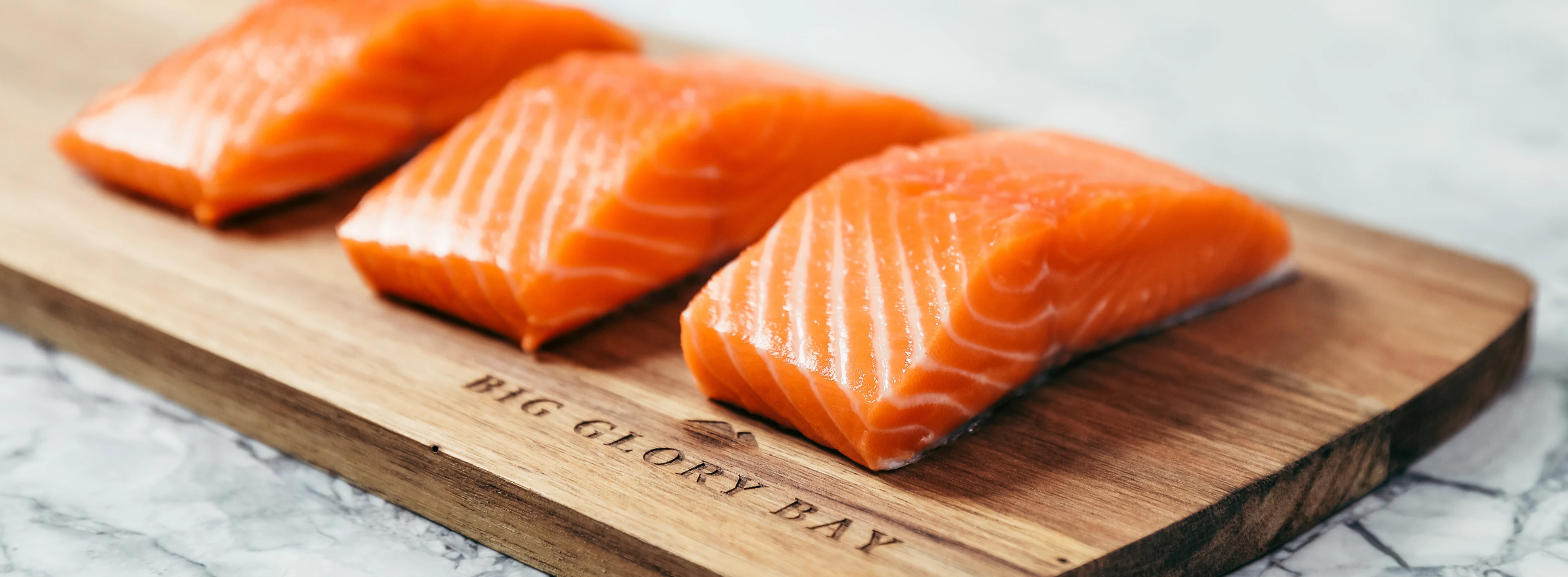OUR KING SALMON
NEW ZEALAND KING SALMON
Less than 1% of global salmon production is New Zealand King Salmon – also known as Chinook Salmon. This rare species is notoriously difficult to produce so most salmon consumed globally is Atlantic Salmon. King Salmon must be farmed with care in superior conditions with plenty of space to thrive and minimal handling.
Our Big Glory Bay King Salmon are sustainably ocean farmed in the pristine coastal waters of Big Glory Bay, in Stewart Island, located at the very bottom of New Zealand. The bay’s pure waters are constantly refreshed by cold currents, keeping the temperature at a chilly 14°C (57°F). That slows the salmon’s growth, giving it time to develop its distinctive rich, smooth flavour.
ETHICAL CHOICE
Big Glory Bay’s isolation, and the purity of its waters, means our fish have always been disease and lice free. We have never had to treat our fish with antibiotics.
We have the credentials to prove our commitment to the wellbeing of our salmon and the sustainability of our environment. Our Big Glory Bay salmon farm is proudly Best Aquaculture Practices (BAP) certified. New Zealand King Salmon is also the first ocean-farmed salmon to achieve the ‘best choice’ green rating from the Monterey Bay Aquarium's Seafood Watch® programme.
Welcome to some of the best salmon in the world.
AWARD WINNING
In 2023, Big Glory Bay became a two-time winner at the Outstanding NZ Food Producer Awards. Our Fresh King Salmon Portions won a gold medal and the FMCG Business Outstanding New Product award. The team of expert food judges noted our salmon was ‘Very clean, sweet flavour. Fine texture and delicious.’
We also took out the Food & Beverage Producer Award at the Primary Industries New Zealand 2023 Awards. Our commitment to sustainable and traceable farming practices was a stand-out for the judges. Another reason why we are the gold standard, from ocean to plate.
Big Glory Bay was also a finalist in the 2023 NZ Food Awards, in the Primary Sector category.
FROM FARM TO PLATE
OUR HATCHERIES
FEEDING
GROWING
HARVESTING
ON YOUR PLATE
SUPERIOR TASTE AND QUALITY
Consistently exceptional flavour and texture.
Luxurious colour with decadent fat layering.
Renowned for its rich flavour, melt-in-the-mouth texture, and clean finish.
Distinctive marbling, with a high oil content and a good source of Omega-3.
The choice of chefs around the world.
Try Our King Salmon
Our award-winning King Salmon feature in the finest restaurants. See here a small selection of restaurants across New Zealand and the USA where you can find our Big Glory Bay King Salmon on the menu. Please contact us to find out where a restaurant is near you.
New Zealand
USA
Our Values
We’re proud of the pristine location of our Big Glory Bay salmon farm, and we’ve taken steps to protect it.
FAQ's Of New Zealand King Salmon
What is the Māori name for King salmon in New Zealand?
New Zealand King salmon (Hāmana in te reo Māori, which is the language of the indigenous people of mainland New Zealand) originates from the North Pacific (USA and Canada), where its Native American name is Chinook and its Latin name is Oncorhynchus tshawytscha. It’s all the same fish. In New Zealand we call it King salmon, which is what the fish is called in Alaska.
Can you find King salmon in New Zealand rivers as well as the ocean?
Absolutely. When King salmon were introduced to New Zealand back in 1890s, they were first released into the fresh water braided rivers. They survived best in the central and lower South Island rivers like the Waitaki, Rakaia and the Rangitata. Wild King salmon spend their life at sea and return to the headwaters of these rivers as adult fish to spawn. They lay their eggs in the river shingles, and once hatched, the young fish swim back down the river to the sea.
Are there any specific regulations or limits for catching King salmon in New Zealand?
Freshwater salmon are regulated by New Zealand Fish and Games Councils. There are catching limits restricting the number of fish recreational fishers can catch each day. Recreational fishers aim to catch salmon at or near to the mouth of the river when the fish are coming back to spawn.
